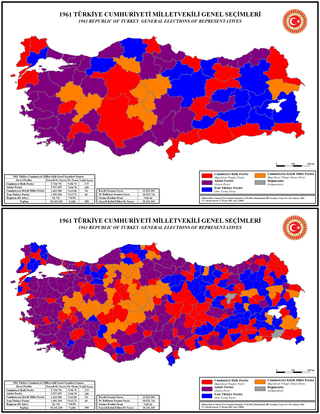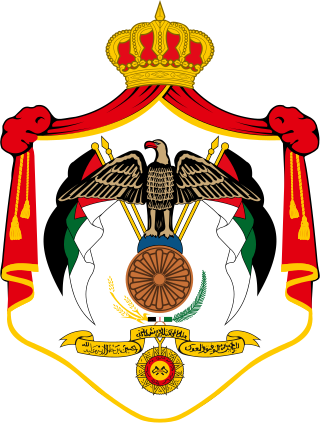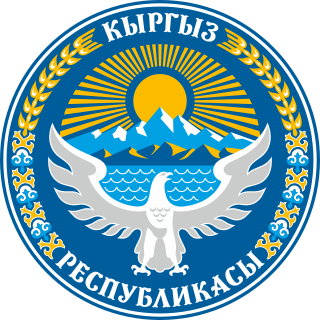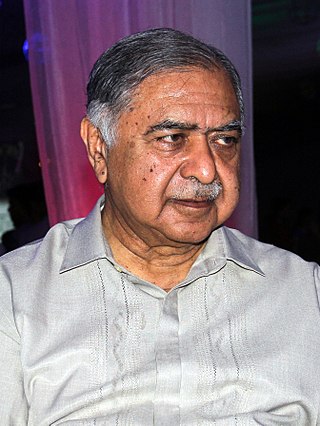
Constituent Assembly elections were held in the Democratic Republic of Georgia between 14 and 16 February 1919. The electoral system used was party-list proportional representation using the D'Hondt method in a single nationwide district. The result was a victory for the Social Democratic Labour Party of Georgia, which won 81% of the vote, and 109 of the 130 seats. In by-elections held in spring, they lost four seats and the Armenian Party in Georgia–Dashnaktsitiuni and the Georgian National Party both won seats.

General elections were held in Turkey on 12 October 1969. The electoral system used was party-list proportional representation using the D'Hondt method in 66 electoral districts. The result was a victory for the Justice Party, which won 256 of the 450 seats. Voter turnout was 64.3%.

General elections were held in Turkey on 10 October 1965. The result was a victory for the Justice Party, which won 240 of the 450 seats. Voter turnout was 71.3%.

General elections were held in Turkey on 15 October 1961. The electoral system used was party-list proportional representation with the D'Hondt method in 67 electoral districts. In order to receive seats in a district, parties needed to win a Hare quota in that district. The Republican People's Party (CHP) emerged as the largest party, winning 173 of the 450 seats. It was the first time the CHP had won the most seats since the 1946 elections. Voter turnout was 81.4%.

General elections were held in Jordan on 29 August 1951. As political parties were banned at the time, all candidates ran as independents, although some affiliated with the Jordanian Communist Party, the Ba'ath Party the Arab Constitutional Party and the Umma Party all won seats.

General elections were held in Jordan on 8 November 1989, the first since 1967. As political parties were banned at the time, all 647 candidates ran as independents, although 22 of the 80 successful candidates were Muslim Brotherhood members. Voter turnout was 53.1%.
General elections were held in Lebanon between 23 August and 11 October 1992, the first since 1972. Independent candidates won the majority of seats, although most of them were considered members of various blocs. Voter turnout was 30.3%.

General elections were held in Lebanon between 27 August and 3 September 2000 to elect the 128 members of the Parliament of Lebanon. Independent candidates won the majority of seats, although most of them were considered members of various blocs. Voter turnout was 40.5%.

Parliamentary elections were held in Syria on 9 October 1953. They were the elections held under the 1953 constitution, which granted universal suffrage to women, scrapping the educational requirements used in previous elections.

Parliamentary elections were held in Syria on 25 and 26 May 1973. The result was a victory for the Arab Socialist Ba'ath Party, which won 122 of the 186 seats. They were also the first elections in which the Syrian-led Ba'ath Party ran for seats in parliament, the original Arab Socialist Ba'ath Party had been dissolved in 1966.

Parliamentary elections were held in Syria on 10 and 11 February 1986. Members were elected using the multiple non-transferable vote in fifteen constituencies, with an average district magnitude of thirteen. The result was a victory for the Arab Socialist Ba'ath Party, which won 130 of the 195 seats.

Parliamentary elections were held in Syria on 22 and 23 May 1990. No political parties were permitted outside the National Progressive Front, though candidates outside this group could run as independents. Approximately 9,000 candidates ran as independents. Members were elected using the multiple non-transferable vote in fifteen districts, with an average district magnitude of 16.6. The result was a victory for the Ba'ath Party, which won 134 of the 250 seats. Voter turnout was 49.6%.

Parliamentary elections were held in Syria on 24 and 25 August 1994. Members were elected using the multiple non-transferable vote in fifteen districts, with an average district magnitude of 16.7. The result was a victory for the Ba'ath Party, which won 135 of the 250 seats. Voter turnout was 61.2%.

Supreme Soviet elections were held in the Kirghiz SSR on 25 February 1990, with a second round on 7 April. At the time, the Communist Party of Kirghizia (PKK) was the only party in the country, with most of the candidates being from large collectives or state organisations. Nevertheless, the Party of Communists won around 90% of the seats in the Supreme Soviet, although some MPs were informally affiliated with the Democratic Movement of Kyrgyzstan.

Presidential elections were held in Bangladesh on 15 November 1981. The result was a victory for the incumbent acting President Abdus Sattar of the Bangladesh Nationalist Party (BNP), who received 65.5% of the vote, beating his principal challenger Kamal Hossain of the Awami League. Voter turnout was 56.5%.

Parliamentary elections were held in Mongolia on 19 June 1977. At the time, the country was a one-party state under the rule of the Mongolian People's Revolutionary Party. The MPRP won 328 of the 354 seats, with the remaining 26 seats going to non-party candidates, who had been chosen by the MPRP due to their social status. Voter turnout was reported to be 100%, with only one of the 694,855 registered voters failing to cast a ballot.

Parliamentary elections were held in Mongolia on 22 June 1986. At the time, the country was a one-party state under the rule of the Mongolian People's Revolutionary Party. The MPRP won 346 of the 370 seats, with the remaining 24 seats going to non-party candidates, who had been chosen by the MPRP due to their social status. Voter turnout was reported to be 100%, with only ten of the 929,403 registered voters failing to cast a ballot.
General elections were held in Siam on 15 November 1933 to elect 78 of the 156 members of the House of Representatives, with the other 78 appointed by the King. The elections were held on an indirect basis, with voters electing sub-district representatives between 10 October and 15 November, and the representatives then electing members of parliament on 16 November.
General elections were held in Siam on 12 November 1938 to elect 91 members of the 182-seat House of Representatives. The other 91 members had been appointed by the King after the 1937 elections. At the time there were no political parties, so all candidates ran as independents. Voter turnout was 35%.
General elections were held in Siam on 29 January 1948. Following the 1947 coup, the unicameral parliament elected in 1946 was abrogated. It was replaced by a bicameral parliament, with a 100-seat appointed Senate and a 99-member House of Representatives.










